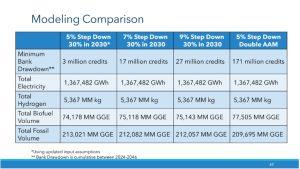Summary of California Low Carbon Fuel Standard Workshop – April 2024
The California Air Resources Board (CARB) held a workshop on April 10, 2024, addressing the proposed regulatory amendments to the California Low Carbon Fuel Standard (LCFS) program. This workshop discussed potential revisions to the rule, as well as sought additional feedback and comments from stakeholders. EcoEngineers is providing the following summary to highlight potential changes and areas of re-evaluation from the initial proposal.
A link to the presentation and supplemental documentation referred to can be found at: LCFS Meetings and Workshops | California Air Resources Board.
For more information, please contact Lisa Hanke at lhanke@ecoengineers.us.
Updated Modeling
CARB proposed four new step-down scenarios under consideration for the final rule. In creation of the new scenarios, CARB has updated the modeling to reflect:
- Increased tailpipe emissions factors for methane (CH4) and nitrous oxide (N2O) affecting renewable diesel, biodiesel, and ultra-low sulfur diesel (ULSD);
- Increased supply assumptions for renewable diesel from virgin oils and waste oils;
- Energy demand from plug-in hybrid electric vehicles (PHEVs) and medium-duty vehicles (MDVs).
The first three of the new scenarios being analyzed reflect step-downs at 5%, 7%, and 9%. All three of the scenarios result in a 30% carbon intensity (CI) reduction by 2030 and a 90% CI reduction by 2045. The fourth scenario being analyzed is a 5% step-down in 2025 with the auto-acceleration mechanism triggered twice. This results in a 39% CI reduction by 2030 and 90% CI reduction in 2043. EcoEngineers had recommended a steeper step-down rate in the company’s written comments to CARB, and several commenters in attendance also supported a steeper step-down, many with preference for 9%.
The following chart from compares the modeled scenarios:

Source: CARB, LCFS Workshop Slide #47
Feedback was requested from CARB to determine the appropriate scenario to implement. Specific feedback requested is shown in the following:
Source: CARB, LCFS Workshop Slide #49
Sustainability Criteria
In addition to the originally proposed regulation, CARB is evaluating an increase in LUC values for high-risk feedstocks and methods to increase traceability, verification, and/or enforcement of waste feedstock. LUC changes may be based on empirical sub-national data, such as remote sensing or satellite monitoring. CARB requested feedback for potential data sources.
Additionally, CARB indicated several times throughout the workshop that they are interested in obtaining feedback for how the proposed sustainability certification should be implemented. Originally proposed regulations were based on existing certification programs, for example, International Sustainability and Carbon Certification (ISCC).
MDV/HDV Infrastructure
Though not a focus of the staff’s presentation, many commenters spoke with concern for the MDV/HDV infrastructure crediting regulations. Specifically, regulations regarding the number of eligible chargers at a specific site, which must be less than 10 under the current proposal, is too low, and geographic siting is a major hinderance. CARB expressed openness to obtaining feedback and updating the rules.
Timeline
The timeline for the implementation of the LCFS amendments was provided and is demonstrated below.
Source: CARB, LCFS Workshop Slide #67






